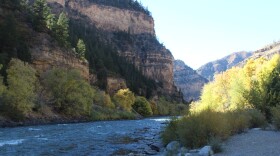-
Warmer temperatures in November meant that less snowpack accumulated. But storms did increase soil moisture in the Upper Colorado River Basin, making future precipitation more likely to run off slopesides and boost rivers and streams.
-
The Colorado River District has cleared an important hurdle in securing the Shoshone water right, which is an in-stream flow agreement with the state. The deal is designed in part to protect Colorado River water levels, and it was approved despite objections from utility companies on the Front Range.
-
In 2021, the City of Longmont signed the first ever sister city agreement with a tribal sovereign nation: the Northern Arapaho Tribe of the Wind River Reservation in Wyoming. Seniors from both communities have forged deep bonds.
-
A Moab resident discovered spray-painted graffiti in Arches National Park in the middle of the 44-day government shutdown. National parks have remained open during that time with little to no staff.
-
Book Swap events are growing in popularity in communities across Colorado’s Front Range and in other parts of the country. They’re a way for readers to pass along gently used books to new homes, and pick up something fresh to read themselves. They’re also helping people make connections.
-
The federal government set a deadline of November 11 for states to have a framework for allocating Colorado River water post-2026. The states missed that deadline, and have failed to produce an agreement.
-
The seven states that use the Colorado River have until November 11th to present a basic plan to the federal government for how to allocate water in the river. But negotiations have been contentious, and spectators aren’t sure whether there will be consensus.
-
One of the last remaining undammed rivers in Colorado, the Crystal River has inspired locals to secure protections for its free-flowing state. A study into how the river shapes the trees on its bank could help their case.
-
The Men’s Shed chapter in Jackson Hole, Wyoming, brings good vibes to tackle serious themes
-
The average farmer in the United States is nearing 60, and most are white men, according to federal data. But on Colorado's Western Slope, one program is trying to change that by training a new and more diverse generation of farmers in the principles of regenerative agriculture.

Play Live Radio
Next Up:
0:00
0:00
Available On Air Stations










